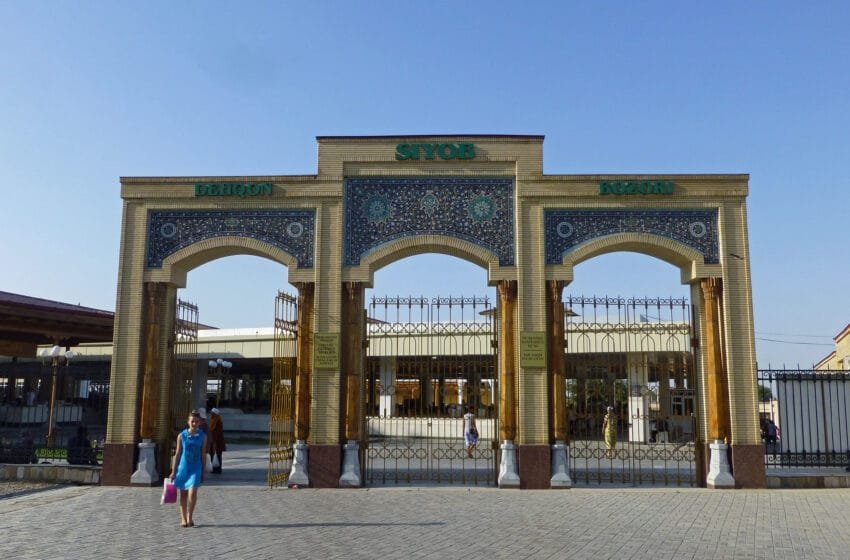Siab Bazaar: A Living Testament to Samarkand’s Rich Heritage with Over 600 Years of History

“Siab Bazaar: A Centuries-Old Living Testament to Samarkand’s Rich Heritage”
The Siab Bazaar (Siyob bozori in Uzbek, Сиёб бозор in Tajik) stands as one of the largest, oldest, and most significant marketplaces not only in Samarkand but across Uzbekistan and Central Asia. Spanning an impressive area of over seven hectares, this bustling bazaar serves as a vibrant hub of commerce, culture, and tradition. Its historical roots, unique location, and rich diversity make it a focal point for locals and a must-visit destination for tourists eager to experience the authentic spirit of Samarkand.
The name “Siab” originates from the Siab district in Samarkand and the nearby Siab River. The term itself translates from Persian and Tajik as “black water” or “black river,” a nod to its geographical and cultural significance.
Prime Location in the Heart of History
Siab Bazaar enjoys a strategic position in Samarkand’s Old City (Eski shahar). This central location places it amidst some of the most iconic landmarks of the region:
- To the south, just 1 kilometer away, lies the world-famous Registan Square, home to a trio of stunning madrasahs.
- Adjacent to the bazaar’s southern entrance are the monumental Bibi-Khanym Mosque and Bibi-Khanym Mausoleum, towering symbols of Timurid architectural grandeur.
- 500 meters east of the bazaar, visitors can explore the mesmerizing Shah-i-Zinda Mausoleum Complex and the historic Hazrat Khizr Mosque.
- To the north, 2 kilometers away, the ancient settlement of Afrosiyab offers insights into Samarkand’s pre-Islamic history.
This proximity to such landmarks underscores Siab Bazaar’s historical and cultural importance as a central hub that has witnessed centuries of trade and interaction.
Architectural Marvel: A Glimpse into the Past
The architecture of Siab Bazaar reflects a harmonious blend of functionality and tradition. Its central structure is a domed building, symbolizing the architectural style of historic trade centers in Central Asia. The main entrance, a striking triple arch adorned with intricate blue majolica tiles, sets the tone for the vibrant marketplace within.
Key Features:
- Seven Covered Pavilions: These house the bazaar’s primary trading rows, offering an organized and visually stunning shopping experience.
- Specialized Sections: Separate areas cater to specific goods such as spices, sweets, meat, and dairy products.
- Commercial Complexes: The Shodiyona Shopping Center (a five-story facility) and the Siab Supermarket provide modern shopping conveniences within the historic setting.
- Food Courts and Eateries: Numerous cafes and stalls offer traditional Uzbek dishes such as plov, samsa, shashlik, and lagman, ensuring visitors can savor the region’s culinary heritage.
- Expansive Grounds: With over seven hectares of space, the bazaar creates a sprawling environment where history and modernity coexist.
Diverse Offerings: A Shopper’s Paradise
Siab Bazaar is famed for its vast and diverse array of goods, catering to both daily needs and unique cultural treasures. Its offerings reflect the rich agricultural and artisanal heritage of Uzbekistan.
Local Specialties:
- Samarkand Bread (lepeshka) and *tandir naan: These iconic baked goods, prepared in traditional clay ovens, are among the most sought-after items.
- Fresh Produce: Seasonal fruits and vegetables, such as pomegranates, grapes, melons, and apricots, highlight the region’s fertile lands.
- Spices: The vibrant displays of saffron, cumin, coriander, and other spices captivate the senses and are essential ingredients in Uzbek cuisine.
Artisanal Goods:
- Handicrafts: The bazaar includes rows of local craftsmen showcasing skills such as wood carving, metal engraving, and pottery making. Visitors can often observe these artisans at work, adding a dynamic layer to the shopping experience.
- Textiles and Embroidery: Traditional Uzbek ikat fabrics, suzani embroideries, and carpets are available in various patterns and colors, each telling a story of the region’s artistic legacy.
Everyday Necessities:
- Meat and dairy products, grains, legumes, and nuts form the backbone of the local diet and are readily available in specialized sections.
- Household goods, clothing, and everyday items are sold in separate pavilions, ensuring a comprehensive shopping experience.
Cultural Significance and Legacy
Beyond commerce, Siab Bazaar serves as a living monument to Samarkand’s storied past. It reflects the city’s role as a crucial node on the Silk Road, where merchants, travelers, and scholars from across Asia, the Middle East, and Europe once converged. The bazaar’s enduring vibrancy is a testament to this legacy, connecting the present to centuries of history.
The bazaar’s inclusion in UNESCO’s World Heritage Site listing, under the designation “Samarkand — Crossroads of Cultures,” underscores its global importance. Visitors walking through its bustling aisles not only engage with the sights, sounds, and smells of a traditional marketplace but also step into a narrative that spans millennia.
Recent Developments and Restoration Efforts
In the mid-20th century, efforts were made to preserve Siab Bazaar as a cultural landmark. However, its most significant transformation occurred in 2005, when the marketplace underwent extensive restoration. This included:
- Removing over three meters of accumulated soil to restore the bazaar’s original height and grandeur.
- Refurbishing its iconic domed structures and reinforcing its architectural integrity.
Today, Siab Bazaar continues to thrive as both a commercial center and a tourist attraction. The restored bazaar seamlessly integrates modern amenities with traditional aesthetics, offering visitors an unparalleled experience of Samarkand’s vibrant culture.
Conclusion
The Siab Bazaar is more than just a marketplace; it is a microcosm of Samarkand’s rich history, vibrant culture, and enduring traditions. Its sprawling pavilions, diverse goods, and lively atmosphere make it a destination where the past and present converge. For locals, it remains a vital part of daily life, while for visitors, it offers an immersive journey into the heart of Uzbekistan’s cultural and commercial heritage.
Whether savoring the taste of fresh Samarkand bread, marveling at the intricate craftsmanship of local artisans, or simply soaking in the vibrant energy of the bazaar, Siab offers an experience that is as unforgettable as the city itself.




